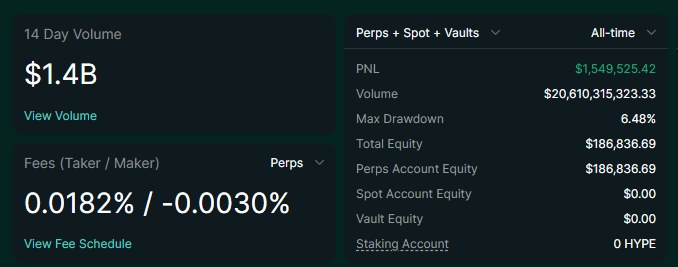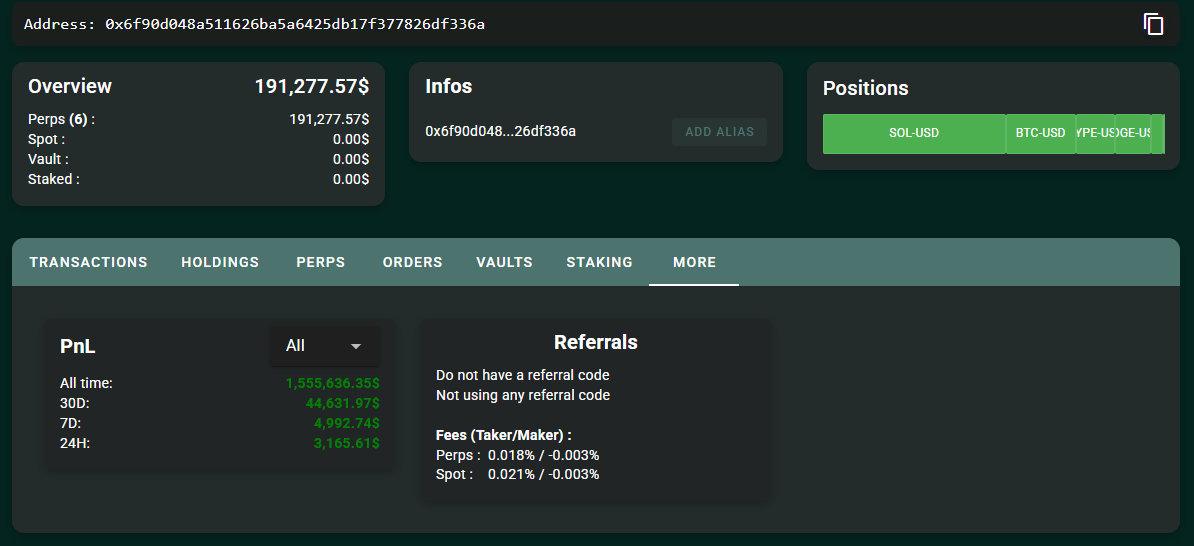-
A Hyperliquid trader has transformed a modest $6,800 investment into $1.5 million by leveraging high-volume market-making orders and earning exchange rebates, bypassing traditional directional trading.
-
This trader generated an astonishing $20.6 billion in total trading volume, capturing over 3% of all maker activity on Hyperliquid, while maintaining minimal market risk through a delta-neutral strategy.
-
According to COINOTAG, the trader’s disciplined, automated liquidity provision approach exemplifies how strategic market-making can outperform speculative trading in decentralized finance.
Discover how a Hyperliquid trader turned $6,800 into $1.5 million by mastering high-frequency market-making and earning rebates, highlighting innovative strategies in DeFi trading.
Hyperliquid’s Market-Making Maverick: Turning Small Capital Into Massive Volume
In the rapidly evolving decentralized finance ecosystem, Hyperliquid has emerged as a platform where innovative trading strategies thrive. A trader using wallet address 0x6f90…336a has quietly amassed over $20.6 billion in trading volume since February 2024, starting with a modest capital base of under $200,000. This feat was accomplished not by speculating on price movements but by executing high-frequency market-making orders that earn rebates from the exchange.
This approach hinges on placing limit orders that provide liquidity to the market, allowing the trader to collect small but consistent rebates. Unlike taker orders, which incur fees, maker orders on Hyperliquid reward liquidity providers with a rebate of 0.0030%, translating to $3 earned per $100,000 in volume. While seemingly minimal, this rebate becomes highly lucrative when scaled through rapid, automated trading.
Delta-Neutral Strategy Minimizes Risk While Maximizing Rebates
The trader’s strategy is characterized by maintaining a delta-neutral position, meaning they avoid directional exposure to price fluctuations. By quoting only one side of the order book at a time—either bids or asks—and keeping net exposure below $100,000, the trader effectively minimizes risk. This disciplined approach contrasts sharply with speculative trading, which often involves significant market risk and volatility.
Such a strategy requires sophisticated automation and real-time market monitoring. The trader likely employs bots capable of instant order placement and cancellation to adapt to market conditions, ensuring stale orders do not expose them to adverse price movements. This high-frequency trading model demands robust infrastructure and a deep understanding of decentralized exchange mechanics.

Scaling Profits Through High-Frequency Market Making on Hyperliquid
Over a 14-day period, the trader achieved $1.4 billion in trading volume, turning over capital hundreds of times daily. This high turnover rate underscores the efficiency of the market-making strategy and the power of compounding small rebates at scale. Despite the rapid trading activity, the trader maintained a maximum drawdown of only 6.48%, highlighting the risk-averse nature of the system.
Such performance is exceptional in decentralized finance, where most traders rely on directional bets or arbitrage opportunities. Instead, this trader’s success demonstrates that disciplined liquidity provision, combined with automation and strategic risk management, can yield substantial profits with relatively low capital.

Technical Expertise and Infrastructure: Keys to Replicating Success
Replicating this strategy is challenging due to the technical expertise and infrastructure required. The trader’s system likely involves low-latency connections, sophisticated algorithms, and continuous market data analysis to optimize order placement. Additionally, managing risk during sudden price shifts necessitates rapid response capabilities to cancel or adjust orders instantly.
While the strategy is highly effective, it is not without operational complexities. Traders must invest in reliable technology and develop a nuanced understanding of exchange fee structures and market dynamics. This combination of skills and resources creates a significant barrier to entry but also an opportunity for those capable of mastering it.
Conclusion
The Hyperliquid trader’s journey from $6,800 to $1.5 million exemplifies the potential of automated, rebate-driven market-making strategies in decentralized finance. By focusing on liquidity provision rather than price speculation, the trader achieved remarkable volume and profits with controlled risk exposure. This case highlights the evolving landscape of crypto trading, where innovation and technical prowess can unlock new avenues for consistent returns. For traders and investors alike, understanding and leveraging such strategies could be key to navigating the future of DeFi markets.
